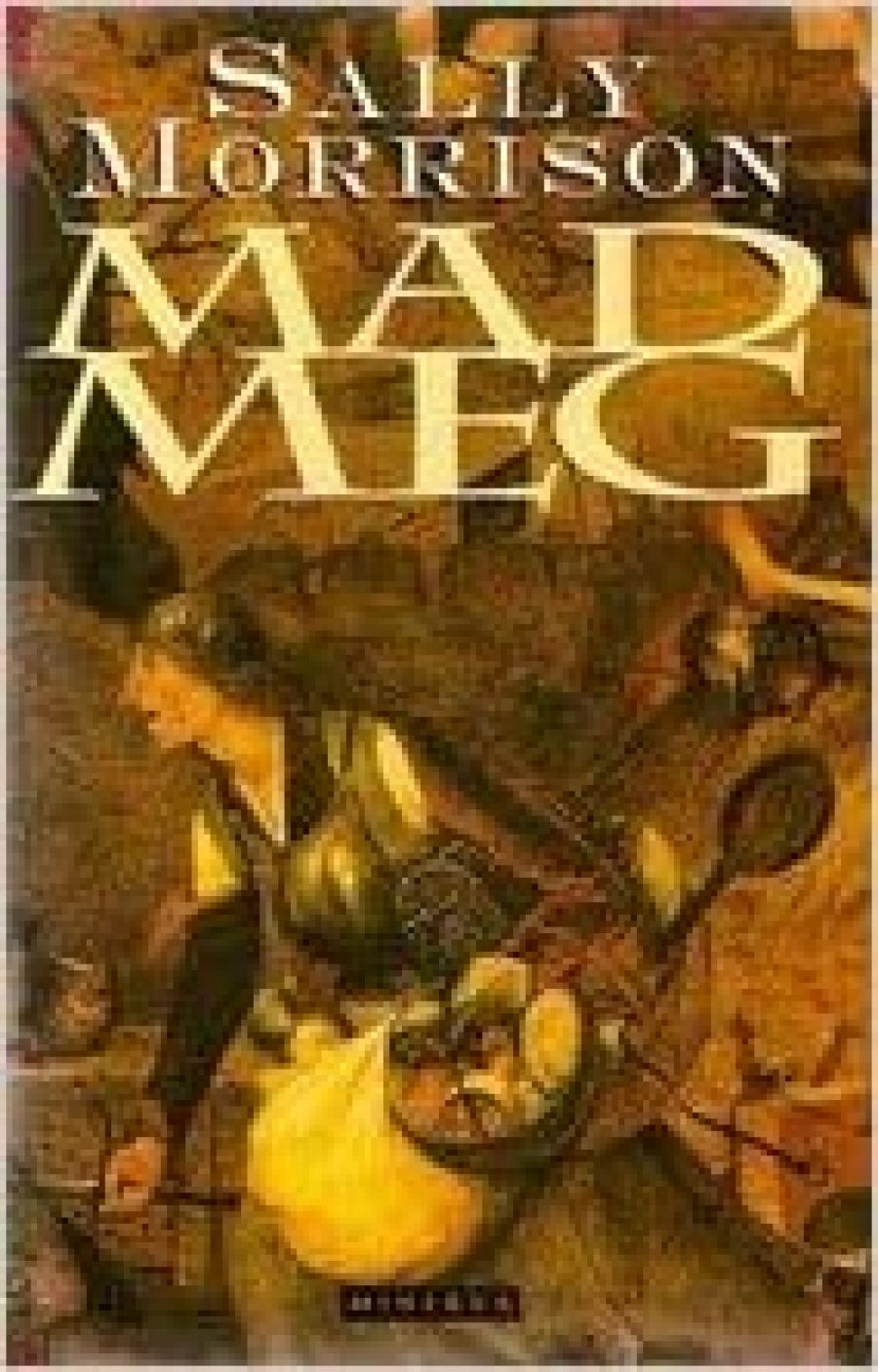
- Free Article: No
- Contents Category: Fiction
- Review Article: Yes
- Article Title: Furore and disarray
- Online Only: No
- Custom Highlight Text:
Midway through Sally Morrison’s new novel, Mad Meg, I began to develop the scissor twitch, an almost overwhelming urge to cut it up and reassemble it into a new structure. Not quite the vandalism it suggests – I read Mad Meg in galley pages, which encourages scissorly desires. It is a vast, kaleidoscopic novel, which opens with a wonderful mischievous energy, full of surprises and pleasures, and laconic wit. Yet it begins to teeter midway and, in my view, ends in unnecessary disarray. Hence the twitch.
- Book 1 Title: Mad Meg
- Book 1 Biblio: WHA, $24.95 hb
This is Morrison’s second novel, the first, Who’s Taking you to the Dance?, published some fifteen years ago, a mosaic narrative about a group of students at a country high school at the end of 1962. In the interim, in 1989, there was her collection of short stories, I Am a Boat, the title story of which was a superb piece. Now a big leap to Mad Meg, an ambitious novel with a circuitous route through much of the twentieth century. Opening in 1956, it too is a mosaic which reaches back to the 1920s, to Italy and Paris in the 1930s, while pushing forward to the present.
Set mainly in Melbourne, Mad Meg is in part a family saga tracing the generations of the Motte and the Coretti families, but its narrative shape keeps chafing and mocking the genre. Some of its preoccupations – the art circles of Melbourne, antifascism, socialism and feminism – take it far beyond the boundaries of generational narrative. Not always in comfortable liaison, it is as much about the sly depredations of history as it is about the eccentric intimacies and ravages of families.
With a large and extraordinary cast, it is a bold novel, with something of the firebrand vigour of Bruegel’s painting, Mad Meg, which keeps reappearing in the novel as if an emblem of all its happenings. In the painting, Mad Meg is on the rampage, gathering the future into her basket as she charges through catastrophe and history in mad furore:
Eggs are cracking all around Mad Meg. The housewives, who have followed her to hell, flay the monsters around her with sticks and swats, but the monsters are our imperfections and failures made flesh and they are perpetual; they swarm up walls and out of water never-endingly. They occupy the sky and burn our horizons.
The Bruegel painting hangs on the kitchen wall in the house where the narrator, Isobel Coretti, now lives with her elderly mother, Stella, née Motte, whose memory is fading, ‘the memory doors thudding shut behind her as she goes’. Isobel, however, is opening memory doors, questing for stories particularly about her Italian-born father, Henry Coretti.
In the first part of the novel, where Isobel and Allegra are adolescent, the narrative weaves in and out of family bric-à-brac, the writing effervescent and feisty. It moves then to their lives in Melbourne, where the sisters are part of the collective that runs the Mad Meg gallery. Both Isobel and her father are painters of some repute and occasionally we hear a little about their exhibitions. While there are some teasing glimpses now and again of their art, we learn much more about the politics of the Melbourne art world, including the battles over the father’s estate.
The family lines of the Mottes and of the Corettis run through the century, from great-grandparents to the children of Isobel and her vivacious sister, Allegra. Once, great-grandfather Motte offered advice to his eleven daughters, ‘Though God has sent them among us for a reason, never marry a madman’. Some of his descendants find that madmen come in many forms, including artists, and women too have their attendant demons.
So too do nations. Following family connections, the novel is increasingly attentive to the 1930s, Italian fascists in Melbourne, the antifascist movement in Italy and the lives of Italian refugees in Paris in the late 1930s. The novel encompasses the stories of a vast array of people on the edges of the families, both past and present, many of them eccentric, like Rose Hirsch, doll-like among her doll collection or the woman who is the caretaker of the local tip where Henry scrounges odd artefacts, images for his surreal paintings.
If many characters are eccentric, so too is the novel. The narrative angle is askew which, at its best, creates a paradoxical flow. Midway it slows, as if losing its shape and propulsion. While the writing remains animated, the narrative line begins to seem scrappy and random. Its conclusion, which takes us back to 1930s Paris, seems to me at once powerful writing and a sequence utterly misplaced. At one point, Isobel remarks, ‘Allegra and I huddled like a pair of waifs on the periphery of our own lives’. The unfortunate effect of the last part of the novel is indeed to leave Isobel huddled on the periphery of the novel.
Across the decades, tossing from past to present, Mad Meg has at times the furious colours of firebrand and maelstrom, at times the more muted tones of the dogged day-by-day. While it offers itself generously along the way, ultimately I found the shape of it frustrating, the pressure points awry, the narrative lines twisted. Perhaps I will yield to the scissorly desire after all, and then read the novel inside Mad Meg.


Comments powered by CComment